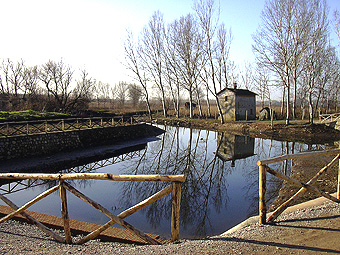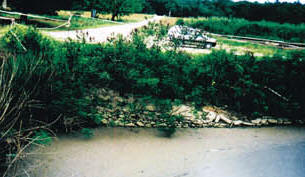
The “Porto de Le Morette”, or Morette Port, lies in an environmentally valuable area between the Fucecchio Marshes Nature Reserve, instituted by the Provinces of Pistoia and Florence, and the Chiusi Woods, itself important from a botanical point of view and for its scenery.
The Port is named after “morette”, an Italian term for diving ducks and especially after the now rare “Moretta tabaccata” or Ferruginous Duck (Aythya nyroca) once common in the Marshes according to the writings of eighteenth century ornithologists.
A few years ago, "Le Morette" also became the name of an area near the port within the important Fucecchio Marshes Nature Reserve. Here, thanks to maintenance work and habitat restoration, the marshes are beginning to recover their old glory.
The Waterways
There is evidence that the marshes have been used as an inland water system since medieval times. The waters from the entire catchment basin ran into the ”Usciana”, the main canal, and emptied into the River Arno, so offering an important link between the Valdinievole valley and Pisa or Florence.
Thus the routes that ran from Pistoia and the hillside belt, like the Via Francigena and other itineraries of local interest, met in the Marshes and passed through Montalbano on their way to the coast.
A side route on Montalbano touched Castelmartini Port near the San Donnino Hospital, and this was the same road used for transporting marble from the Apuan Alps to Pistoia.
The marshes remained in use as a waterway over time and maintenance was continued to keep at least the main canals navigable, in spite of the alternating episodes in the history of the marshes that in the long run tended to favour reclamation of the land.
In 1780, over fifty harbour buildings were still standing. These were often just simple landing places or berthings for different types of boats: from the small “noccolelli” that became the typical “barchini” (small boats) to larger goods vessels such as “barconi” (big boats) and “navecelli” (little ships”). Today only the “barchini”, typical flat-bottomed boats blackened with pitch, are still in use, especially by hunters
Transporting marsh grasses in a historical photograph
of Morette Port (about 1930).
Posing on a “barcone” (a larger type of boat) that carried
goods (1930-40).
The characteristic hunters’ “barchino” (little boat)
used in the Marshes (about 1960).
The old “Port Morette”
Unlike the other ports in the Marshes, the Morette was a wet dock with its banks strengthened by stone walls, a sign of how important this landing point was along the navigational routes.
The historical maps of 1700 already show a “Porto delle Morette” that can be identified as the present port of the same name, probably built after the “Old Morette Port” more to the north became unusable.
Maps compiled in 1800 show a very different port from the one seen today. A bank separated the harbour building from an area described as “resede” that sloped down to the Terzo Canal and was flooded during the winter months, and delimited a deeper canal that could be navigated by larger vessels.
The present structure of the Morette Port cannot be dated precisely for lack of documentation, but in all probability it was designed back in 1800, before the marshland economy began to decline in the last century.
Morette Bridge
The Morette Bridge dates back to 1938, a year that saw two other building works: one for the reconstruction and enlargement of the “Le Morette” farmhouse (as testified by the date on the façade) and the other for reinforcing the port.
The Criachi Hut
Facing the Port, on the bank opposite the Terzo Canal, is the Casotto del Criachi, or Criachi Hut, one of the typical marshland buildings.
These huts along the main canals were used for several different purposes: the first floor served as a temporary resting place for hunters and peasants, whilst the ground floor (that was flooded when the rivers were in spate) was used for storing agricultural and fishing equipment.
The plaque on the south wall of the Criachi Hut is in memory of the victims of the 23rd August, 1944 massacre.
Casotto del Criachi, Criachi Hut (1920-30).
Restoration works
In 2003, the Consorzio di Bonifica del Padule di Fucecchio, (Consortium for the Reclamation of the Fucecchio Marshes), under the scientific supervision of the Centro di Ricerca, Documentazione e Promozione del Padule di Fucecchio (Centre for Research, Documentation and Promotion of the Fucecchio Marshes), completed a restoration project for the Morette Port that also included demolition and reconstruction of the adjoining bridge.
The work was financed by the Regione Toscana (Tuscany Region), the Province of Pistoia, the Comune of Larciano and the Consortium for Reclamation within the ambit of the Region’s “Lungo le Rotte Migratorie” (Along the Migratory Routes) project.

Morette Port before restoration (2003).



